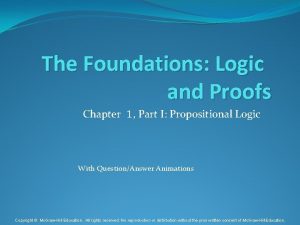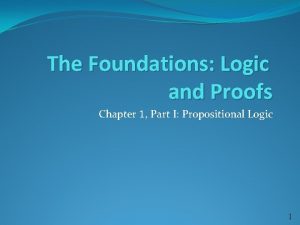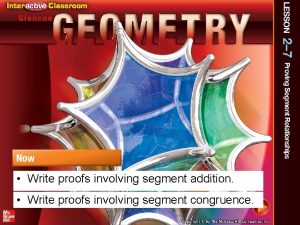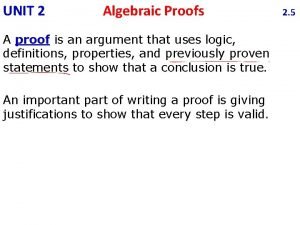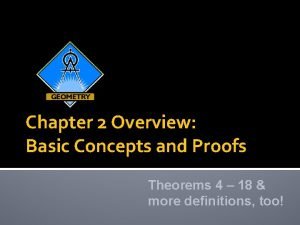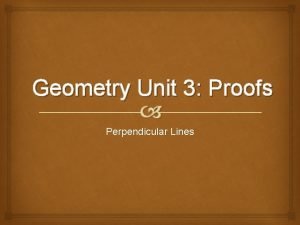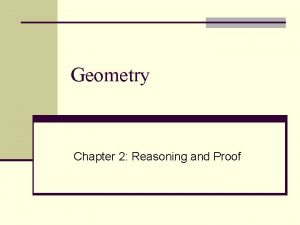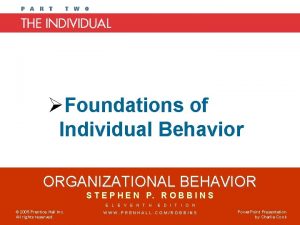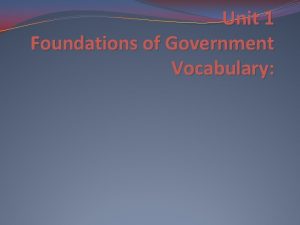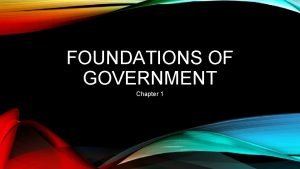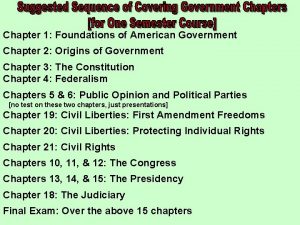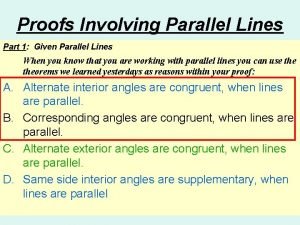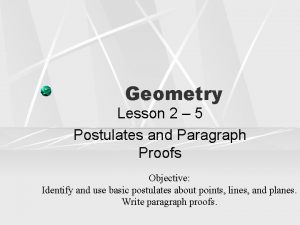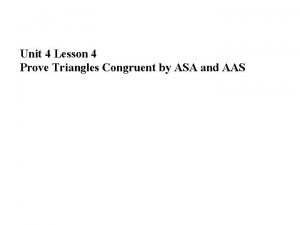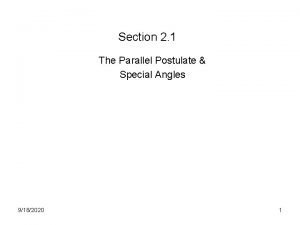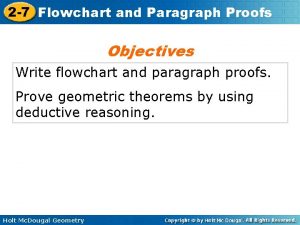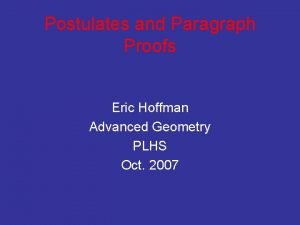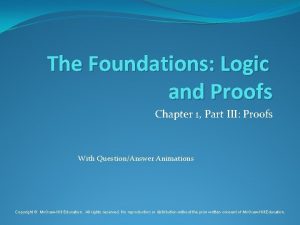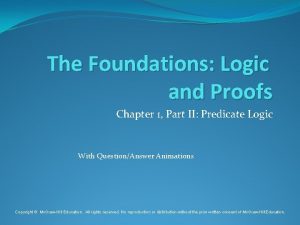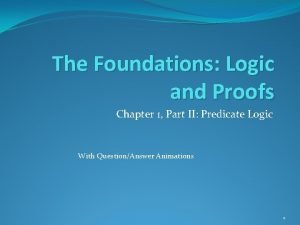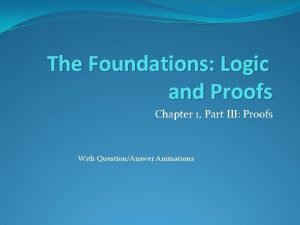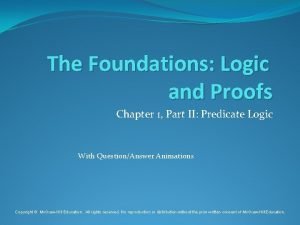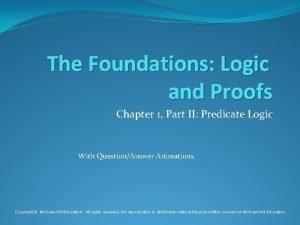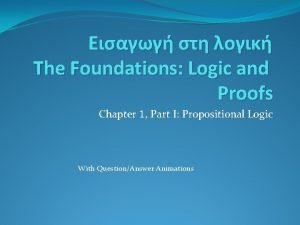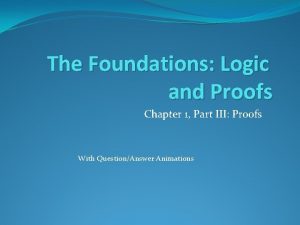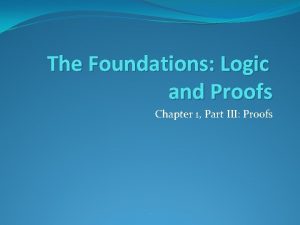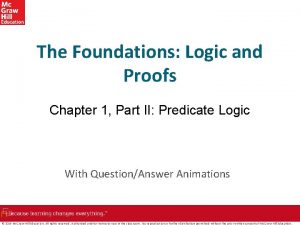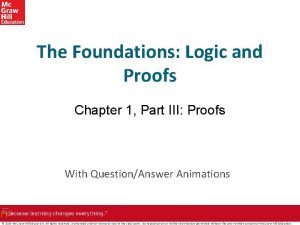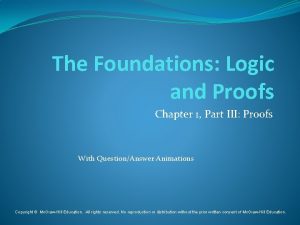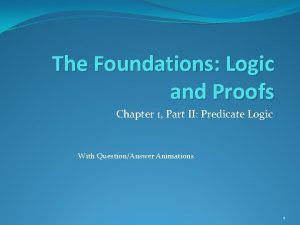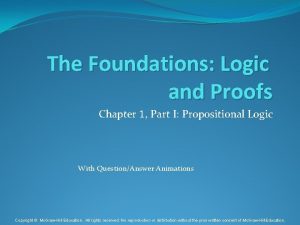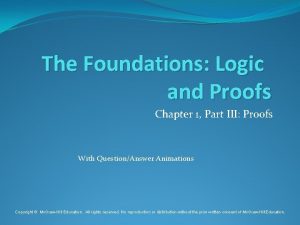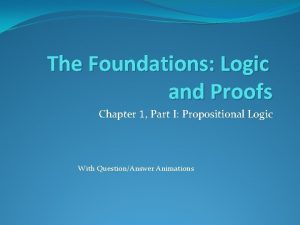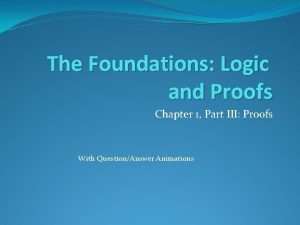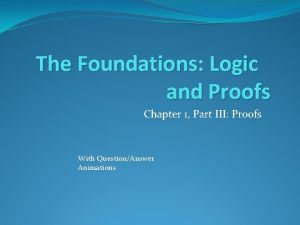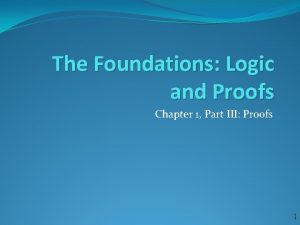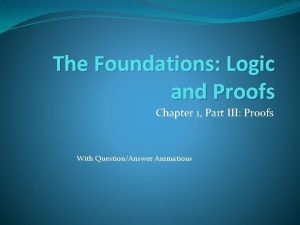The Foundations Logic and Proofs Chapter 1 Part

























































- Slides: 57

The Foundations: Logic and Proofs Chapter 1, Part II: Predicate Logic With Question/Answer Animations

Summary Predicate Logic (First-Order Logic (FOL), Predicate Calculus) The Language of Quantifiers Logical Equivalences Nested Quantifiers Translation from Predicate Logic to English Translation from English to Predicate Logic

Predicates and Quantifiers Section 1. 4

Section Summary Predicates Variables Quantifiers Universal Quantifier Existential Quantifier Negating Quantifiers De Morgan’s Laws for Quantifiers Translating English to Logic Programming (optional)

Propositional Logic Not Enough If we have: “All men are mortal. ” “Socrates is a man. ” Does it follow that “Socrates is mortal? ” Can’t be represented in propositional logic. Need a language that talks about objects, their properties, and their relations. Later we’ll see how to draw inferences.

Introducing Predicate Logic Predicate logic uses the following new features: Variables: x, y, z Predicates: P(x), M(x) Quantifiers (to be covered in a few slides ): Propositional functions are a generalization of propositions. They contain variables and a predicate, e. g. , P(x) Variables can be replaced by elements from their domain.

Propositional Functions Propositional functions become propositions (and have truth values) when their variables are each replaced by a value from the domain (or bound by a quantifier, as we will see later). The statement P(x) is said to be the value of the propositional function P at x. For example, let P(x) denote “x > 0” and the domain be the integers. Then: P(-3) is false. P(0) is false. P(3) is true. Often the domain is denoted by U. So in this example U is the integers.

Examples of Propositional Functions Let “x + y = z” be denoted by R(x, y, z) and U (for all three variables) be the integers. Find these truth values: R(2, -1, 5) Solution: F R(3, 4, 7) Solution: T R(x, 3, z) Solution: Not a Proposition Now let “x - y = z” be denoted by Q(x, y, z), with U as the integers. Find these truth values: Q(2, -1, 3) Solution: T Q(3, 4, 7) Solution: F Q(x, 3, z) Solution: Not a Proposition

Compound Expressions Connectives from propositional logic carry over to predicate logic. If P(x) denotes “x > 0, ” find these truth values: P(3) ∨ P(-1) P(3) ∧ P(-1) P(3) → P(-1) Solution: T Solution: F Solution: T Expressions with variables are not propositions and therefore do not have truth values. For example, P(3) ∧ P(y) P(x) → P(y) When used with quantifiers (to be introduced next), these expressions (propositional functions) become propositions.

Quantifiers Charles Peirce (1839 -1914) We need quantifiers to express the meaning of English words including all and some: “All men are Mortal. ” “Some cats do not have fur. ” The two most important quantifiers are: Universal Quantifier, “For all, ” symbol: Existential Quantifier , “There exists, ” symbol: We write as in x P(x) and x P(x) asserts P(x) is true for every x in the domain. x P(x) asserts P(x) is true for some x in the domain. The quantifiers are said to bind the variable x in these expressions.

Universal Quantifier x P(x) is read as “For all x, P(x)” or “For every x, P(x)” Examples: 1) If P(x) denotes “x > 0” and U is the integers, then x P(x) is 2) 3) false. If P(x) denotes “x > 0” and U is the positive integers, then x P(x) is true. If P(x) denotes “x is even” and U is the integers, then x P(x) is false.

Existential Quantifier x P(x) is read as “For some x, P(x)”, or as “There is an x such that P(x), ” or “For at least one x, P(x). ” Examples: 1. 2. 3. If P(x) denotes “x > 0” and U is the integers, then x P(x) is true. It is also true if U is the positive integers. If P(x) denotes “x < 0” and U is the positive integers, then x P(x) is false. If P(x) denotes “x is even” and U is the integers, then x P(x) is true.

Uniqueness Quantifier (optional) !x P(x) means that P(x) is true for one and only one x in the universe of discourse. This is commonly expressed in English in the following equivalent ways: “There is a unique x such that P(x). ” “There is one and only one x such that P(x)” Examples: 1. 2. If P(x) denotes “x + 1 = 0” and U is the integers, then !x P(x) is true. But if P(x) denotes “x > 0, ” then !x P(x) is false. The uniqueness quantifier is not really needed as the restriction that there is a unique x such that P(x) can be expressed as: x (P(x) ∧ y (P(y) → y =x))

Thinking about Quantifiers When the domain of discourse is finite, we can think of quantification as looping through the elements of the domain. To evaluate x P(x) loop through all x in the domain. If at every step P(x) is true, then x P(x) is true. If at a step P(x) is false, then x P(x) is false and the loop terminates. To evaluate x P(x) loop through all x in the domain. If at some step, P(x) is true, then x P(x) is true and the loop terminates. If the loop ends without finding an x for which P(x) is true, then x P(x) is false. Even if the domains are infinite, we can still think of the quantifiers this fashion, but the loops will not terminate in some cases.

Properties of Quantifiers The truth value of x P(x) and x P(x) depend on both the propositional function P(x) and on the domain U. Examples: If U is the positive integers and P(x) is the statement “x < 2”, then x P(x) is true, but x P(x) is false. 2. If U is the negative integers and P(x) is the statement “x < 2”, then both x P(x) and x P(x) are true. 3. If U consists of 3, 4, and 5, and P(x) is the statement “x > 2”, then both x P(x) and x P(x) are true. But if P(x) is the statement “x < 2”, then both x P(x) and x P(x) are false. 1.

Precedence of Quantifiers The quantifiers and have higher precedence than all the logical operators. For example, x P(x) ∨ Q(x) means ( x P(x))∨ Q(x) x (P(x) ∨ Q(x)) means something different. Unfortunately, often people write x P(x) ∨ Q(x) when they mean x (P(x) ∨ Q(x)).

Translating from English to Logic Example 1: Translate the following sentence into predicate logic: “Every student in this class has taken a course in Java. ” Solution: First decide on the domain U. Solution 1: If U is all students in this class, define a propositional function J(x) denoting “x has taken a course in Java” and translate as x J(x). Solution 2: But if U is all people, also define a propositional function S(x) denoting “x is a student in this class” and translate as x (S(x)→ J(x)). x (S(x) ∧ J(x)) is not correct. What does it mean?

Translating from English to Logic Example 2: Translate the following sentence into predicate logic: “Some student in this class has taken a course in Java. ” Solution: First decide on the domain U. Solution 1: If U is all students in this class, translate as x J(x) Solution 1: But if U is all people, then translate as x (S(x) ∧ J(x)) x (S(x)→ J(x)) is not correct. What does it mean?

Returning to the Socrates Example Introduce the propositional functions Man(x) denoting “x is a man” and Mortal(x) denoting “x is mortal. ” Specify the domain as all people. The two premises are: The conclusion is: Later we will show to prove that the conclusion follows from the premises.

Equivalences in Predicate Logic Statements involving predicates and quantifiers are logically equivalent if and only if they have the same truth value for every predicate substituted into these statements and for every domain of discourse used for the variables in the expressions. The notation S ≡T indicates that S and T are logically equivalent. Example: x ¬¬S(x) ≡ x S(x)

Thinking about Quantifiers as Conjunctions and Disjunctions If the domain is finite, a universally quantified proposition is equivalent to a conjunction of propositions without quantifiers and an existentially quantified proposition is equivalent to a disjunction of propositions without quantifiers. If U consists of the integers 1, 2, and 3: Even if the domains are infinite, you can still think of the quantifiers in this fashion, but the equivalent expressions without quantifiers will be infinitely long.

Negating Quantified Expressions Consider x J(x) “Every student in your class has taken a course in Java. ” Here J(x) is “x has taken a course in calculus” and the domain is students in your class. Negating the original statement gives “It is not the case that every student in your class has taken Java. ” This implies that “There is a student in your class who has not taken calculus. ” Symbolically ¬ x J(x) and x ¬J(x) are equivalent

Negating Quantified Expressions (continued) Now Consider x J(x) “There is a student in this class who has taken a course in Java. ” Where J(x) is “x has taken a course in Java. ” Negating the original statement gives “It is not the case that there is a student in this class who has taken Java. ” This implies that “Every student in this class has not taken Java” Symbolically ¬ x J(x) and x ¬J(x) are equivalent

De Morgan’s Laws for Quantifiers The rules for negating quantifiers are: The reasoning in the table shows that: These are important. You will use these.

Translation from English to Logic Examples: 1. “Some student in this class has visited Mexico. ” Solution: Let M(x) denote “x has visited Mexico” and S(x) denote “x is a student in this class, ” and U be all people. x (S(x) ∧ M(x)) 2. “Every student in this class has visited Canada or Mexico. ” Solution: Add C(x) denoting “x has visited Canada. ” x (S(x)→ (M(x)∨C(x)))

Some Fun with Translating from English into Logical Expressions U = {fleegles, snurds, thingamabobs} F(x): x is a fleegle S(x): x is a snurd T(x): x is a thingamabob Translate “Everything is a fleegle” Solution: x F(x)

Translation (cont) U = {fleegles, snurds, thingamabobs} F(x): x is a fleegle S(x): x is a snurd T(x): x is a thingamabob “Nothing is a snurd. ” Solution: ¬ x S(x) What is this equivalent to? Solution: x ¬ S(x)

Translation (cont) U = {fleegles, snurds, thingamabobs} F(x): x is a fleegle S(x): x is a snurd T(x): x is a thingamabob “All fleegles are snurds. ” Solution: x (F(x)→ S(x))

Translation (cont) U = {fleegles, snurds, thingamabobs} F(x): x is a fleegle S(x): x is a snurd T(x): x is a thingamabob “Some fleegles are thingamabobs. ” Solution: x (F(x) ∧ T(x))

Translation (cont) U = {fleegles, snurds, thingamabobs} F(x): x is a fleegle S(x): x is a snurd T(x): x is a thingamabob “No snurd is a thingamabob. ” Solution: ¬ x (S(x) ∧ T(x)) What is this equivalent to? Solution: x (¬S(x) ∨ ¬T(x))

Translation (cont) U = {fleegles, snurds, thingamabobs} F(x): x is a fleegle S(x): x is a snurd T(x): x is a thingamabob “If any fleegle is a snurd then it is also a thingamabob. ” Solution: x ((F(x) ∧ S(x))→ T(x))

System Specification Example Predicate logic is used for specifying properties that systems must satisfy. For example, translate into predicate logic: “Every mail message larger than one megabyte will be compressed. ” “If a user is active, at least one network link will be available. ” Decide on predicates and domains (left implicit here) for the variables: Let L(m, y) be “Mail message m is larger than y megabytes. ” Let C(m) denote “Mail message m will be compressed. ” Let A(u) represent “User u is active. ” Let S(n, x) represent “Network link n is state x. Now we have:

Lewis Carroll Example Charles Lutwidge Dodgson (AKA Lewis Caroll) (1832 -1898) The first two are called premises and the third is called the conclusion. 1. 2. 3. “All lions are fierce. ” “Some lions do not drink coffee. ” “Some fierce creatures do not drink coffee. ” Here is one way to translate these statements to predicate logic. Let P(x), Q(x), and R(x) be the propositional functions “x is a lion, ” “x is fierce, ” and “x drinks coffee, ” respectively. 1. x (P(x)→ Q(x)) 2. x (P(x) ∧ ¬R(x)) 3. x (Q(x) ∧ ¬R(x)) Later we will see how to prove that the conclusion follows from the premises.

Some Predicate Calculus Definitions (optional) An assertion involving predicates and quantifiers is valid if it is true for all domains every propositional function substituted for the predicates in the assertion. Example: An assertion involving predicates is satisfiable if it is true for some domains some propositional functions that can be substituted for the predicates in the assertion. Otherwise it is unsatisfiable. Example: not valid but satisfiable unsatisfiable

More. Predicate Calculus Definitions (optional) The scope of a quantifier is the part of an assertion in which variables are bound by the quantifier. Example: x has wide scope Example: x has narrow scope

Logic Programming (optional) Prolog (from Programming in Logic) is a programming language developed in the 1970 s by researchers in artificial intelligence (AI). Prolog programs include Prolog facts and Prolog rules. As an example of a set of Prolog facts consider the following: instructor(chan, math 273). instructor(patel, ee 222). instructor(grossman, cs 301). enrolled(kevin, math 273). enrolled(juna, ee 222). enrolled(juana, cs 301). enrolled(kiko, math 273). enrolled(kiko, cs 301). Here the predicates instructor(p, c) and enrolled(s, c) represent that professor p is the instructor of course c and that student s is enrolled in course c.

Logic Programming (cont) In Prolog, names beginning with an uppercase letter are variables. If we have apredicate teaches(p, s) representing “professor p teaches student s, ” we can write the rule: teaches(P, S) : - instructor(P, C), enrolled(S, C). This Prolog rule can be viewed as equivalent to the following statement in logic (using our conventions for logical statements). p c s(I(p, c) ∧ E(s, c)) → T(p, s))

Logic Programming (cont) Prolog programs are loaded into a Prolog interpreter. The interpreter receives queries and returns answers using the Prolog program. For example, using our program, the following query may be given: ? enrolled(kevin, math 273). Prolog produces the response: yes Note that the ? is the prompt given by the Prolog interpreter indicating that it is ready to receive a query.

Logic Programming (cont) The query: ? enrolled(X, math 273). produces the response: X = kevin; X = kiko; no The query: ? teaches(X, juana). produces the response: X = patel; X = grossman; no The Prolog interpreter tries to find an instantiation for X. It does so and returns X = kevin. Then the user types the ; indicating a request for another answer. When Prolog is unable to find another answer it returns no.

Logic Programming (cont) The query: ? teaches(chan, X). produces the response: X = kevin; X = kiko; no A number of very good Prolog texts are available. Learn Prolog Now! is one such text with a free online version at http: //www. learnprolognow. org/ There is much more to Prolog and to the entire field of logic programming.

Nested Quantifiers Section 1. 5

Section Summary Nested Quantifiers Order of Quantifiers Translating from Nested Quantifiers into English Translating Mathematical Statements into Statements involving Nested Quantifiers. Translated English Sentences into Logical Expressions. Negating Nested Quantifiers.

Nested Quantifiers Nested quantifiers are often necessary to express the meaning of sentences in English as well as important concepts in computer science and mathematics. Example: “Every real number has an inverse” is x y(x + y = 0) where the domains of x and y are the real numbers. We can also think of nested propositional functions: x y(x + y = 0) can be viewed as x Q(x) where Q(x) is y P(x, y) where P(x, y) is (x + y = 0)

Thinking of Nested Quantification Nested Loops To see if x y. P (x, y) is true, loop through the values of x : At each step, loop through the values for y. If for some pair of x andy, P(x, y) is false, then x y. P(x, y) is false and both the outer and inner loop terminate. x y P(x, y) is true if the outer loop ends after stepping through each x. To see if x y. P(x, y) is true, loop through the values of x: At each step, loop through the values for y. The inner loop ends when a pair x and y is found such that P(x, y) is true. If no y is found such that P(x, y) is true the outer loop terminates as x y. P(x, y) has been shown to be false. x y P(x, y) is true if the outer loop ends after stepping through each x. If the domains of the variables are infinite, then this process can not actually be carried out.

Order of Quantifiers Examples: 1. Let P(x, y) be the statement “x + y = y + x. ” Assume that U is the real numbers. Then x y. P(x, y) and y x. P(x, y) have the same truth value. 2. Let Q(x, y) be the statement “x + y = 0. ” Assume that U is the real numbers. Then x y. P(x, y) is true, but y x. P(x, y) is false.

Questions on Order of Quantifiers Example 1: Let U be the real numbers, Define P(x, y) : x ∙ y = 0 What is the truth value of the following: 1. x y. P(x, y) Answer: False 2. x y. P(x, y) Answer: True 3. x y P(x, y) Answer: True 4. x y P(x, y) Answer: True

Questions on Order of Quantifiers Example 2: Let U be the real numbers, Define P(x, y) : x / y = 1 What is the truth value of the following: 1. x y. P(x, y) Answer: False 2. x y. P(x, y) Answer: True 3. x y P(x, y) Answer: False 4. x y P(x, y) Answer: True

Quantifications of Two Variables Statement When True? When False P(x, y) is true for every pair x, y. There is a pair x, y for which P(x, y) is false. For every x there is a y for There is an x such that which P(x, y) is true. P(x, y) is false for every y. There is an x for which P(x, y) is true for every y. For every x there is a y for which P(x, y) is false. There is a pair x, y for which P(x, y) is true. P(x, y) is false for every pair x, y

Translating Nested Quantifiers into English Example 1: Translate the statement x (C(x )∨ y (C(y ) ∧ F(x, y))) where C(x) is “x has a computer, ” and F(x, y) is “x and y are friends, ” and the domain for both x and y consists of all students in your school. Solution: Every student in your school has a computer or has a friend who has a computer. Example 1: Translate the statement x y z ((F(x, y)∧ F(x, z) ∧ (y ≠z))→¬F(y, z)) Solution: Every student none of whose friends are also friends with each other.

Translating Mathematical Statements into Predicate Logic Example : Translate “The sum of two positive integers is always positive” into a logical expression. Solution: 1. Rewrite the statement to make the implied quantifiers and domains explicit: “For every two integers, if these integers are both positive, then the sum of these integers is positive. ” 2. Introduce the variables x and y, and specify the domain, to obtain: “For all positive integers x and y, x + y is positive. ” 3. The result is: x y ((x > 0)∧ (y > 0)→ (x + y > 0)) where the domain of both variables consists of all integers

Translating English into Logical Expressions Example: Use quantifiers to express the statement “There is a woman who has taken a flight on every airline in the world. ” Solution: 1. Let P(w, f ) be “w has taken f ” and Q(f, a) be “f is a flight on a. ” 2. The domain of w is all women, the domain of f is all flights, and the domain of a is all airlines. 3. Then the statement can be expressed as: w a f (P(w, f ) ∧ Q(f, a))

Calculus in Logic (optional) Example: Use quantifiers to express the definition of the limit of a real-valued function f(x) of a real variable x at a point a in its domain. Solution: Recall the definition of the statement is “For every real number ε > 0, there exists a real number δ > 0 such that |f(x) – L| < ε whenever 0 < |x –a| < δ. ” Using quantifiers: Where the domain for the variables ε and δ consists of all positive real numbers and the domain for x consists of all real numbers.

Questions on Translation from English Choose the obvious predicates and express in predicate logic. Example 1: “Brothers are siblings. ” Solution: x y (B(x, y) → S(x, y)) Example 2: “Siblinghood is symmetric. ” Solution: x y (S(x, y) → S(y, x)) Example 3: “Everybody loves somebody. ” Solution: x y L(x, y) Example 4: “There is someone who is loved by everyone. ” Solution: y x L(x, y) Example 5: “There is someone who loves someone. ” Solution: x y L(x, y) Example 6: “Everyone loves himself” Solution: x L(x, x)

Negating Nested Quantifiers Example 1: Recall the logical expression developed three slides back: w a f (P(w, f ) ∧ Q(f, a)) Part 1: Use quantifiers to express the statement that “There does not exist a woman who has taken a flight on every airline in the world. ” Solution: ¬ w a f (P(w, f ) ∧ Q(f, a)) Part 2: Now use De Morgan’s Laws to move the negation as far inwards as possible. Solution: 1. ¬ w a f (P(w, f ) ∧ Q(f, a)) 2. w ¬ a f (P(w, f ) ∧ Q(f, a)) by De Morgan’s for 3. w a ¬ f (P(w, f ) ∧ Q(f, a)) by De Morgan’s for 4. w a f ¬ (P(w, f ) ∧ Q(f, a)) by De Morgan’s for 5. w a f (¬ P(w, f ) ∨ ¬ Q(f, a)) by De Morgan’s for ∧. Part 3: Can you translate the result back into English? Solution: “For every woman there is an airline such that for all flights, this woman has not taken that flight or that flight is not on this airline”

Return to Calculus and Logic (Opt) Example : Recall the logical expression developed in the calculus example three slides back. Use quantifiers and predicates to express that does not exist. 1. We need to say that for all real numbers L, 2. The result from the previous example can be negated to yield: 3. Now we can repeatedly apply the rules for negating quantified expressions: The last step uses the equivalence ¬(p→q) ≡ p∧¬q

Calculus in Predicate Logic (optional) 4. Therefore, to say that for all real numbers L, expressed as: does not exist means can be Remember that ε and δ range over all positive real numbers and x over all real numbers. 5. Translating back into English we have, for every real number L, there is a real number ε > 0, such that for every real number δ > 0, there exists a real number x such that 0 < | x – a | < δ and |f(x) – L | ≥ ε.

Some Questions about Quantifiers (optional) Can you switch the order of quantifiers? Is this a valid equivalence? Solution: Yes! The left and the right side will always have the same truth value. The order in which x and y are picked does not matter. Is this a valid equivalence? Solution: No! The left and the right side may have different truth values for some propositional functions for P. Try “x + y = 0” for P(x, y) with U being the integers. The order in which the values of x and y are picked does matter. Can you distribute quantifiers over logical connectives? Is this a valid equivalence? Solution: Yes! The left and the right side will always have the same truth value no matter what propositional functions are denoted by P(x) and Q(x). Is this a valid equivalence? Solution: No! The left and the right side may have different truth values. Pick “x is a fish” for P(x) and “x has scales” for Q(x) with the domain of discourse being all animals. Then the left side is false, because there are some fish that do not have scales. But the right side is true since not all animals are fish.
 The foundations logic and proofs
The foundations logic and proofs The foundations logic and proofs
The foundations logic and proofs Lesson 10 unknown angle proofs-proofs with constructions
Lesson 10 unknown angle proofs-proofs with constructions Lesson 9 unknown angle proofs
Lesson 9 unknown angle proofs Statements and reason
Statements and reason Unit 2 logic and proof algebraic proof worksheet
Unit 2 logic and proof algebraic proof worksheet Chapter 2 basic concepts and proofs answers
Chapter 2 basic concepts and proofs answers Chapter 3 proofs with perpendicular lines
Chapter 3 proofs with perpendicular lines Geometry chapter 2 proofs worksheet
Geometry chapter 2 proofs worksheet Congruent triangles chapter 4 answers
Congruent triangles chapter 4 answers First order logic vs propositional logic
First order logic vs propositional logic First order logic vs propositional logic
First order logic vs propositional logic First order logic vs propositional logic
First order logic vs propositional logic Combinational logic circuit vs sequential
Combinational logic circuit vs sequential Tw
Tw Software project wbs example
Software project wbs example Combinational logic sequential logic
Combinational logic sequential logic Combinational logic sequential logic 차이
Combinational logic sequential logic 차이 Logic chapter 3
Logic chapter 3 Foundations of a healthy relationship
Foundations of a healthy relationship Chapter 6 skills for healthy relationships
Chapter 6 skills for healthy relationships Describe the care team and the chain of command
Describe the care team and the chain of command Chapter 2 foundations of individual behavior
Chapter 2 foundations of individual behavior Guided reading activity foundations of government lesson 2
Guided reading activity foundations of government lesson 2 Chapter 4 foundations background to american history
Chapter 4 foundations background to american history Foundations u.com
Foundations u.com Chapter 1 foundations of government vocabulary
Chapter 1 foundations of government vocabulary Chapter 1: foundations of government pdf
Chapter 1: foundations of government pdf Foundations of government (chapter 1 test form a)
Foundations of government (chapter 1 test form a) Proofs of work and bread pudding protocols
Proofs of work and bread pudding protocols Proofs involving parallel and perpendicular lines
Proofs involving parallel and perpendicular lines 2-5 postulates and paragraph proofs answers
2-5 postulates and paragraph proofs answers Unit 4 homework 5 proving triangles congruent
Unit 4 homework 5 proving triangles congruent Types of special angles
Types of special angles Paragraph proof in geometry
Paragraph proof in geometry How to write a paragraph proof
How to write a paragraph proof Euclidean geometry grade 11 reasons
Euclidean geometry grade 11 reasons Paragraph proof definition
Paragraph proof definition Hình ảnh bộ gõ cơ thể búng tay
Hình ảnh bộ gõ cơ thể búng tay Bổ thể
Bổ thể Tỉ lệ cơ thể trẻ em
Tỉ lệ cơ thể trẻ em Voi kéo gỗ như thế nào
Voi kéo gỗ như thế nào Tư thế worm breton
Tư thế worm breton Alleluia hat len nguoi oi
Alleluia hat len nguoi oi Các môn thể thao bắt đầu bằng tiếng bóng
Các môn thể thao bắt đầu bằng tiếng bóng Thế nào là hệ số cao nhất
Thế nào là hệ số cao nhất Các châu lục và đại dương trên thế giới
Các châu lục và đại dương trên thế giới Công thức tính độ biến thiên đông lượng
Công thức tính độ biến thiên đông lượng Trời xanh đây là của chúng ta thể thơ
Trời xanh đây là của chúng ta thể thơ Mật thư anh em như thể tay chân
Mật thư anh em như thể tay chân Phép trừ bù
Phép trừ bù độ dài liên kết
độ dài liên kết Các châu lục và đại dương trên thế giới
Các châu lục và đại dương trên thế giới Thể thơ truyền thống
Thể thơ truyền thống Quá trình desamine hóa có thể tạo ra
Quá trình desamine hóa có thể tạo ra Một số thể thơ truyền thống
Một số thể thơ truyền thống Cái miệng bé xinh thế chỉ nói điều hay thôi
Cái miệng bé xinh thế chỉ nói điều hay thôi
